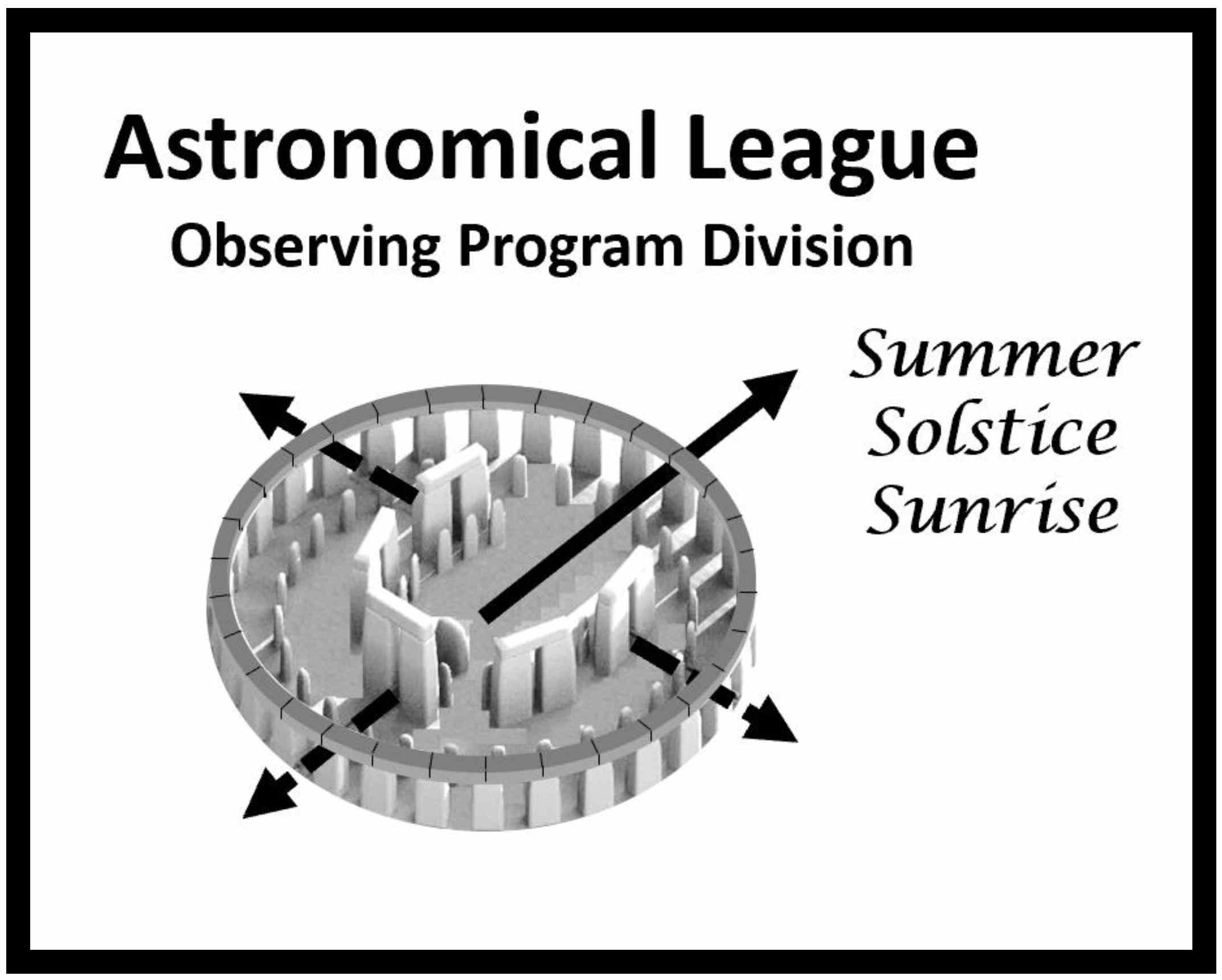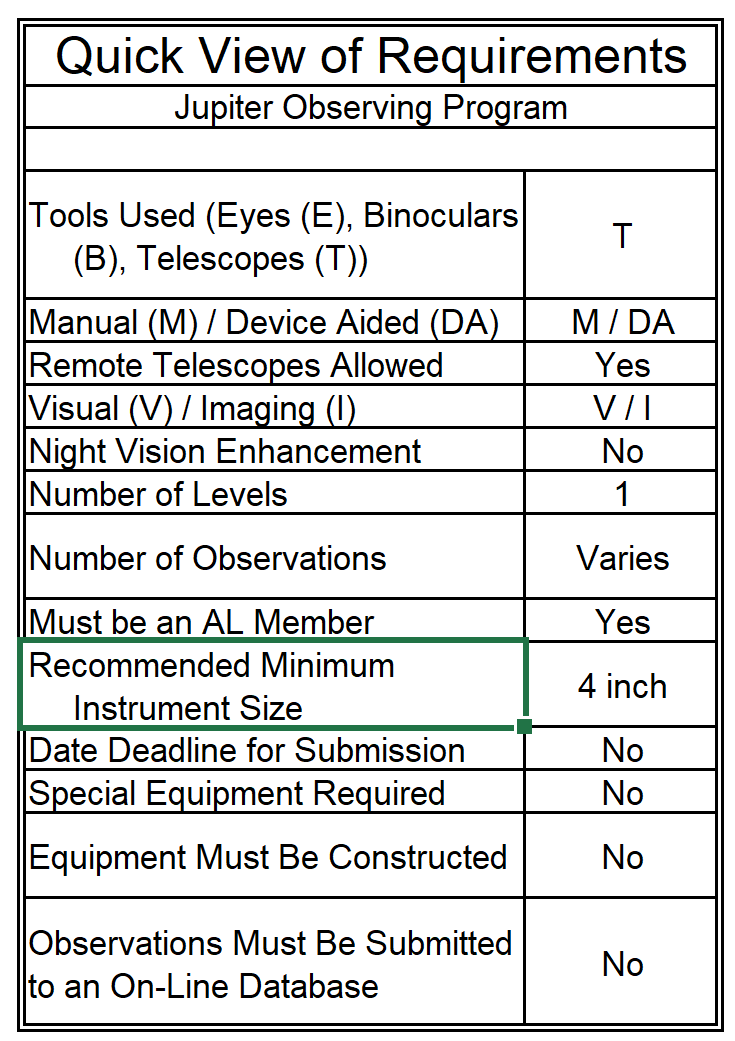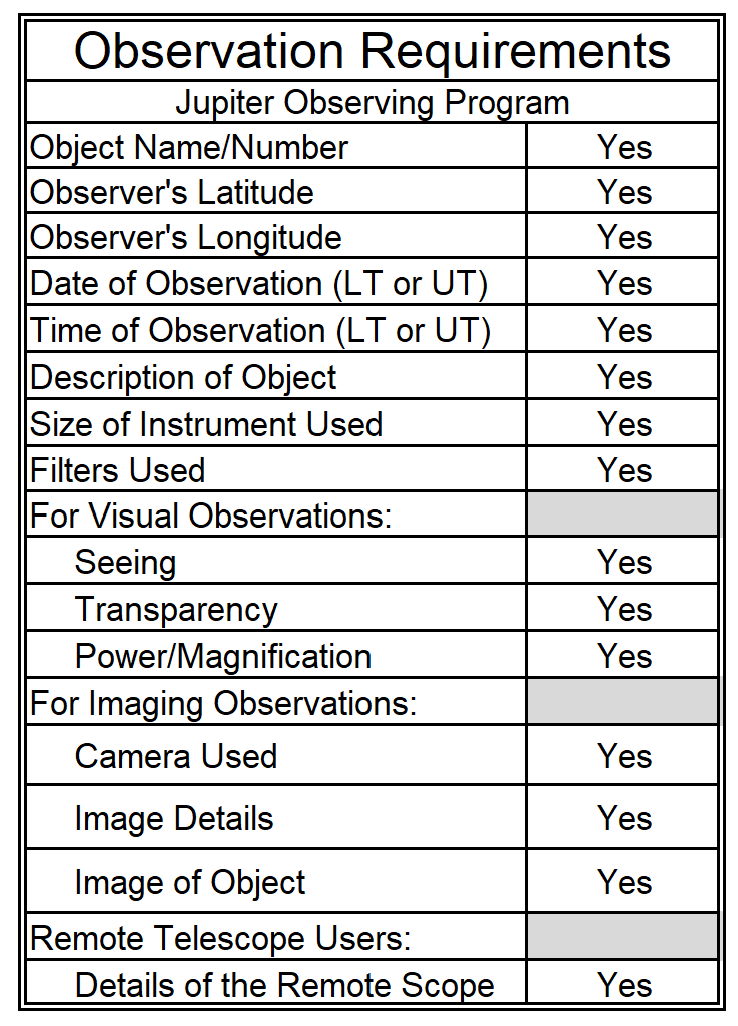Jupiter Observing Program Coordinator:Douglas Smith
6032 S. Nantac Rim Dr.
Tucson, Az 85706
(520) 396-3233
|
 |
IntroductionWelcome to the Jupiter Observing Program of the Astronomical League. Participation in this program will enhance your observing skills, and upon its completion, you will have contributed scientific observations which will be available to those who can use them for scientific analysis. Jupiter’s ever-changing face is fascinating to observe, and the sense of personal accomplishment in observing it can be great. This Observing Program is a direct replacement for the AL 75th Anniversary Observing Challenge that celebrated the Astronomical League’s 75th anniversary. Those who completed the Observing Challenge will be awarded certificate 0 and will receive both certificates and the pin. Approximately every 13 months we are treated to a Jupiter apparition. This is the time it takes for the Earth to complete an orbit (1 Earth year) and then also time to catch up to Jupiter as it progresses in its orbit (1/12 of 12 years). Just as other outer planets are largest when they are in opposition, this is true as well for Jupiter. The most noticeable features are the dark bands and the great red spot. But close inspection often reveals many fine details in the bands. The Galilean Moons are also fascinating objects to observe. |
 |
Background Information
Oppositions of Jupiter:
These are oppositions of Jupiter and the constellations that Jupiter will be in for each one:
- November 1, 2023: Aries
- December 6, 2024: Taurus
- January 9, 2026: Gemini
- February 10, 2027: Leo
- March 13, 2028: Virgo
- April 13, 2029: Virgo
- May 14, 2030: Libra
- June 16, 2031: Ophiuchus
- July 20, 2032: Sagittarius
- August 25, 2033: Aquarius
- The Orbital Period for Jupiter is 12 Earth years. This results in Jupiter visiting the different constellations that are along the ecliptic.
- The rotational period of Jupiter is 9 hours and 56 minutes. This means that features will move significantly during long observing sessions.
- The atmospheric winds at different latitudes will vary. This may give the impression of different planetary rotation rates.
Requirements and Rules
IT IS STRONGLY RECOMMENDED THAT YOU CONTACT THE PROGRAM COORDINATOR PRIOR TO STARTING THIS PROGRAM TO REVIEW PROCEDURES, AND TIPS, AND TO ASK AND RECEIVE ANSWERS TO ANY QUESTIONS
Requirements:
- There are 75 observations in this Observing Program.
- The Great Red Spot Observations (20 observations)
- The objective of this series of observations is to observe and document changes in the size and shape of the Great Red Spot.
- Do these observations over at least a month’s time.
- Up to two per night, at least an hour apart.
- Capture as much detail as possible of the Great Red Spot to be able to note changes in its size, shape, and appearance.
- They contain the most detail if they are done close to the opposition.
- Rotation Period of Jupiter at the Latitude of the Great Red Spot
-
- The objective of these series of observations is to try to determine the rotation period of Jupiter at the latitude of the Great Red Spot.
- Part 1: Limb to Transit, or Transit to Limb (10 observations)
- Do two sequences of 5 observations each (for a total of 10 observations).
- Sequences may be either from the limb to the meridian (5 observations) or from the meridian to the limb (5 observations).
- Observations in each sequence should be about 30 to 45 minutes apart.
- One observation in each sequence should be when the Great Red Spot is crossing the Meridian (Transiting).
- Another observation in each sequence should be when the Great Red Spot is close to the limb.
- Assuming each sequence to be 1/4 of the rotation period for the planet for the Great Red Spot, calculate the Rotational Period (For comparison: The actual period of the rotation of Jupiter’s Great Red Spot is 9 hours and 56 minutes).
- Part 2: Near Transit (5 observations)
- Observations should be done during a single transit of the meridian.
- Observations should be taken from an hour before to an hour after meridian transit.
- Observations should be taken about 30 minutes apart.
- Estimate the longitude change between the first observation and the last observation.
- Based on this data, estimate the rotation rate of Jupiter for the latitude of the Great Red Spot.
- Compare this result to your result from Part 1.
-
- Orbits of the Galilean Moons (20 observations)
- The objective of this series of observations is to try and determine which moons are which. It may also be possible to determine their orbital periods.
- Observe on four or five different nights.
- Do four or five observations each night, at least 30 minutes apart.
- Plot the location of the moons relative to the planet and show the actual orbits to determine which moon is which from this data.
- Orbits of the Galilean Moons (20 observations)
-
- Changes in Jupiter’s Atmosphere (10 observations)
- The objective of this series of observations is to observe and document changes in the markings of Jupiter’s atmosphere.
- On 10 different nights, make a detailed observation of features of Jupiter’s atmosphere.
- The most detail will be visible close to the opposition.
- Jupiter’s TOES (Transits, Occultations, Eclipses, and Shadow Transits between Jupiter and its Galilean Moons. For the Astronomical League Galileo’s TOES certification, click here.) (10 observations)
- Transit – start, transit, end
- Observe and note the time of the start of a transit of a moon
- Observe and note the time when the moon transits Jupiter’s meridian
- Observe and note the time of the end of a transit of a moon
- Occultation – start, end
- Observe and note the time of the start of an occultation of a moon
- Observe and note the time of the end of an occultation of a moon
- Eclipse – start, end
- Observe and note the time of the start of an eclipse of a moon
- Observe and note the time of the end of an eclipse of a moon
- Shadow Transit – start, transit, end
- Observe and note the time of the start of a shadow transit of a moon
- Observe and note the time when the moon’s shadow transits Jupiter’s meridian
- Observe and note the time of the end of a shadow transit of a moon
- Transit – start, transit, end
- Optional Special Challenge: Observe Jupiter’s moons naked eye. The Astronomical League would like to know which ones you can see and how difficult it is.
Rules:This certification is available to members of the Astronomical League, either through their local astronomical society or as members at large. If you are not a member and would like to become one, check with your local astronomical society, search for a local society on the Astronomical League Website, or join as a Member-at-Large. Remote telescopes may be used for this Observing Program as long as the submitter is responsible for directing the telescope. Participants are required to record their observations, including sketches, on the observing form used by the Mars Section of the Association of Lunar and Planetary Observers (A.L.P.O.) or equivalent. These completed forms should be scanned or copied. The Observing Forms are available here: PDF version or MS Word version. Submitting for CertificationAfter you have completed the required observations they should be scanned or copied. The copies should be sent to the Coordinator of the Jupiter Observing Program. Do NOT send the original logs, they will not be returned. The certificate and pin will be sent once the information is verified. The submission should include a completed Submission Form (PDF version or MS Word version). |
 |
Jupiter Observing Program Coordinator:Douglas Smith
6032 S. Nantac Rim Dr.
Tucson, Az 85706
(520) 396-3233
|
 |
Upon verification of your submission and of your active membership in the Astronomical League, your recognition (certificate, pin, etc.) will be sent to you or to the awards coordinator for your society, as you specified. Your name will also appear in an upcoming issue of the Reflector magazine and in the Astronomical League’s online database. Congratulations. Good luck with your next observing challenge.



